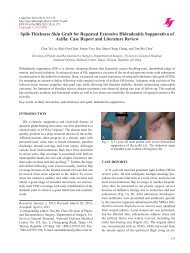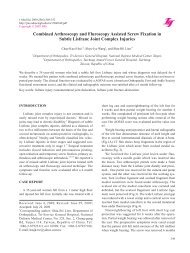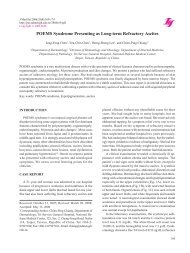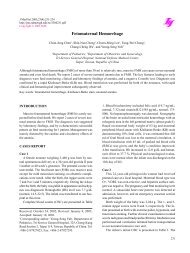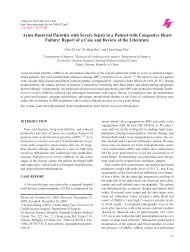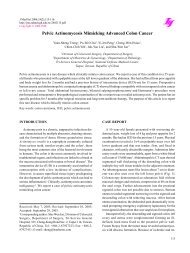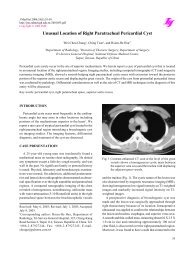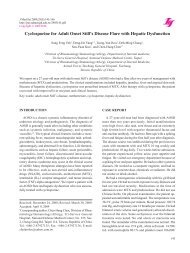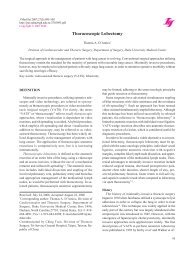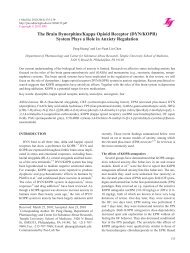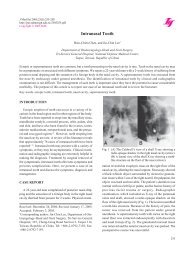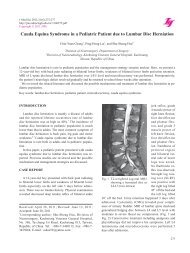A Prospective Evaluation of Efficacy and Safety Profiles of the Novel ...
A Prospective Evaluation of Efficacy and Safety Profiles of the Novel ...
A Prospective Evaluation of Efficacy and Safety Profiles of the Novel ...
Create successful ePaper yourself
Turn your PDF publications into a flip-book with our unique Google optimized e-Paper software.
J Med Sci 2009;29(5):257-264<br />
http://jms.ndmctsgh.edu.tw/2905257.pdf<br />
Copyright © 2009 JMS<br />
Received: June 5, 2009; Revised: July 23, 2009;<br />
Accepted: August 17, 2009<br />
* Corresponding author:<br />
Jiann- Torng Chen, Department <strong>of</strong> ophthalmology, Triservice<br />
General Hospital, National Defense Medical<br />
Center, No. 325, Sec. 2, Cheng-gong Road, Taipei 114,<br />
Taiwan, Republic <strong>of</strong> China. Tel: +886-2-87629163; Fax:<br />
+886-2-87927164; E-mail: jt66chen@ms32.hinet.net<br />
Jy-Been Liang, et al.<br />
A <strong>Prospective</strong> <strong>Evaluation</strong> <strong>of</strong> Effi cacy <strong>and</strong> <strong>Safety</strong> Pr<strong>of</strong>i les <strong>of</strong> <strong>the</strong> <strong>Novel</strong> Hiline<br />
Overnight Orthokeratology Contact Lens for <strong>the</strong> Temporary<br />
Reduction <strong>of</strong> Myopia<br />
Jy-Been Liang 1 , Chia-Hung Li 1,2 , Richard Wu 3 , Huey-Chuan Chen 4 , <strong>and</strong> Jiann- Torng Chen 1*<br />
1<br />
Department <strong>of</strong> ophthalmology Tri-service General hospital, National Defense Medical Center, Taipei;<br />
2<br />
Department <strong>of</strong> Ophthalmology, Hualien Armed Forces General Hospital, Hualien;<br />
3<br />
Department <strong>of</strong> Optometry, Central Taiwan University <strong>of</strong> Science <strong>and</strong> Technology, Taichung;<br />
4<br />
Department <strong>of</strong> Ophthalmology Mackay Memorial Hospital, Taipei,<br />
Taiwan, Republic <strong>of</strong> China<br />
Background: Orthokeratology is <strong>the</strong> programmed application <strong>of</strong> rigid gas-permeable contact lenses for <strong>the</strong> temporary<br />
reduction <strong>of</strong> myopia. New reverse geometry contact lens designs <strong>and</strong> materials have led to a renewed interest in this fi eld.<br />
The purpose <strong>of</strong> this study was to evaluate effi cacy <strong>and</strong> safety pr<strong>of</strong>i les <strong>of</strong> <strong>the</strong> Hiline orthokeratology contact lens in <strong>the</strong><br />
temporary reduction <strong>of</strong> myopia when worn overnight. Methods: Eighty-two myopic subjects (161 eyes; 22 males <strong>and</strong><br />
59 females; mean age, 26.5 years, range 12 to 47 years) were recruited from <strong>the</strong> Tri-Service General Hospital <strong>and</strong> <strong>the</strong><br />
Mackay Memorial Hospital. Subjects received a 36-week trial <strong>of</strong> overnight orthokeratology using reverse geometry rigid<br />
contact lenses (using Boston Equalens II (oprifocon A) lens material by DreamLens Inc.). The oxygen permeability was<br />
85 by ISO/Fatt <strong>and</strong> each subject underwent a 4-week follow-up period after discontinuing wearing <strong>the</strong> lenses. After commencing<br />
lens wear, subjects were examined on day 1, weeks 1, 2, 4, 12, 24, <strong>and</strong> 36, <strong>and</strong> days 1, 7, <strong>and</strong> 28 after a fi nal<br />
evaluation. Visual acuity was checked with <strong>the</strong> Snellen chart: autorefraction by <strong>the</strong> Nikon autokeratometer; corneal topography<br />
<strong>and</strong> corneal thickness with <strong>the</strong> Orbscan II; <strong>and</strong> slit-lamp examinations were performed to check <strong>the</strong> corneal condition<br />
at each session. Success was defi ned by improvement in uncorrected Snellen visual acuity <strong>of</strong> ≥ 2 lines with ≥20/40<br />
unaided distance Snellen visual acuity at <strong>the</strong> fi nal evaluation. Results: Sixty-four subjects (128 eyes) completed <strong>the</strong> study.<br />
The uncorrected visual acuity improved signifi cantly by day 7. The success rate at <strong>the</strong> fi nal evaluation was 100% in both<br />
eyes for all subjects <strong>and</strong> <strong>the</strong> most signifi cant change occurred between day 1 <strong>and</strong> day 7. Conclusion: Hiline overnight orthokeratology<br />
is an effective way <strong>of</strong> temporarily reducing myopia. At <strong>the</strong> fi nal visit, <strong>the</strong> success rates were 100%. The effi<br />
cacy <strong>of</strong> <strong>the</strong> orthokeratology lens in reducing myopia was confi rmed because <strong>the</strong> lower bound <strong>of</strong> <strong>the</strong> 95% confi dence interval<br />
for subjects was greater than <strong>the</strong> prespecifi ed 85%. Changes were more prominent in <strong>the</strong> fi rst week after treatment,<br />
particularly on day 1, <strong>and</strong> reached a maximal effect in week 1. Visual acuity was not correlated to refractive changes. A<br />
possible explanation for this is that <strong>the</strong> autorefractor checks <strong>the</strong> paracentral cornea, whereas a subject sees through <strong>the</strong><br />
more central <strong>and</strong> fl atter regions <strong>of</strong> <strong>the</strong> cornea. Thinning <strong>of</strong> <strong>the</strong> corneal epi<strong>the</strong>lium indicates that a possible mechanism <strong>of</strong><br />
corneal remodeling is redistribution <strong>of</strong> <strong>the</strong> epi<strong>the</strong>lium.<br />
Key words: orthokeratology, myopia, reverse geometry contact lens<br />
INTRODUCTION<br />
It is well established that wearing rigid gas-permeable<br />
contact lenses can produce changes in corneal curvature 1 .<br />
Orthokeratology is <strong>the</strong> temporary reduction in myopia by<br />
<strong>the</strong> programmed application <strong>of</strong> rigid contact lenses. Specifically,<br />
flat-fitting rigid contact lenses produce reductions<br />
in myopia by fl attening <strong>the</strong> corneal curvature.<br />
The fi rst large-scale investigation <strong>of</strong> orthokeratology<br />
was conducted by Kerns who compared subjects wearing<br />
flat-fitting poly(methyl methacrylate) (PMMA) contact<br />
lenses during <strong>the</strong> day with subjects wearing spectacles<br />
<strong>and</strong> subjects wearing conventionally fi tted PMMA lenses.<br />
Orthokeratology contact lenses were 0.25 diopters<br />
(D) to 0.50 D fl atter than <strong>the</strong> fl atter keratometry reading.<br />
257
Effi cacy <strong>and</strong> safety <strong>of</strong> Hiline orthokeratology lens<br />
REFERENCES<br />
1. Carney LG. The basis for corneal shape change<br />
during contact lens wear. Am J Optom Phys Opt<br />
1975;52:445-454.<br />
2. Dave T, Ruston D. Current trends in modern orthokeratology.<br />
Ophthalmic Physiol Opt 1998;18:224-233.<br />
3. Kern RL. Research in orthokeratology. Part II: Experimental<br />
design protocol <strong>and</strong> method. J Am Optom<br />
Assoc 1976;47:1275-1285.<br />
4. Kerns RL. Research in orthokeratology. Part I: Introduction<br />
<strong>and</strong> background. J Am Optom Assoc<br />
1976;47:1047-1051.<br />
5. Kern RL. Research in orthokeratology. Part III:<br />
Results <strong>and</strong> observations. J Am Optom Assoc<br />
1976;47:1505-1515.<br />
6. Polse KA, Br<strong>and</strong> RJ, Vastine DW, Schwalbe JS. Corneal<br />
change accompanying orthokeratology. Plastic<br />
or elastic? Results <strong>of</strong> a r<strong>and</strong>omized controlled clinical<br />
trial. Arch Ophthalmol 1983;101:1873-1878.<br />
7. Binder PS, May CH, Grant SC. An evaluation <strong>of</strong> orthokeratology.<br />
Ophthalmology 1980;87:729-744.<br />
8. Br<strong>and</strong> RJ, Polse KA, Schwalbe JS. The Berkeley Orthokeratology<br />
Study, Part I: General conduct <strong>of</strong> <strong>the</strong><br />
study. Am J Optom Phys Opt 1983;60:175-186.<br />
9. Holden BA, Mertz GW, McNally JJ: Corneal swelling<br />
response to contact lenses worn under extended wear<br />
conditions. Invest Ophthalmol Vis Sci 1983;24:218<br />
264<br />
10. Carkeet NL, Mountford JA, Carney LG. Predicting<br />
success with retrospective analysis <strong>of</strong> ocular characteristics.<br />
Optom Vis Sci 1995;72:892-898.<br />
11. Liang JB, Chou PI, Wu R, Lee YM. Corneal iron ring<br />
associated with orthokeratology. J Cataract Refract<br />
Surg 2003;29:624–626<br />
12. Freeman RA. Predicting stable change in orthokeratology.<br />
Contact Lens Forum 1978;3:21-31.<br />
13. Kerns RL. Research in orthokeratology. Part VIII: Results,<br />
conclusions <strong>and</strong> discussion <strong>of</strong> techniques. J Am<br />
Optom Assoc 1978;49:308-314.<br />
14. Heng LS, Khoo CY. Can contact lenses control <strong>the</strong><br />
progression <strong>of</strong> myopia? Singapore Med J 1994;35:367<br />
–370.<br />
15. Pratt-Johnson JA, Warner DM. Contact lenses<br />
<strong>and</strong> corneal curvature changes. Am J Ophthalmol<br />
1965;60:852-855.<br />
16. Grant SC, May CH. Orthokeratology: control <strong>of</strong> refractive<br />
errors through contact lenses. J Am Optom<br />
Assoc 1971;42:1277-1283.<br />
17. Polse KA, Br<strong>and</strong> RJ, Keener RJ, Schwalbe JS, Vastine<br />
DW. The Berkeley Orthokeratology Study, Part II:<br />
<strong>Safety</strong>. Am J Optom Phys Opt 1983;60:321-328.



